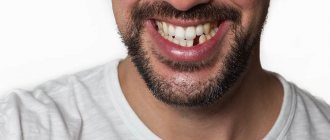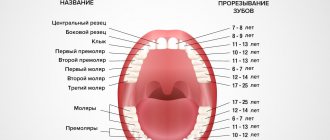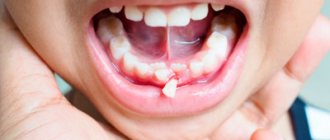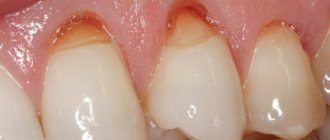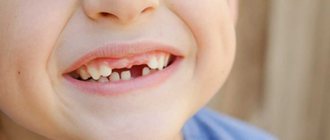The first reaction of parents who notice that their child is growing a second row of teeth is natural fear. In dentistry, it is generally accepted that there are two causes of pathology:
- abnormal growth of molars;
- polyodontia or supernumerary teeth.
Normally, permanent teeth replace baby teeth only after the latter fall out. The germ of the molar tooth stretches upward, thereby contributing to the destruction of the roots. With some features of jaw development, this does not happen, which is why the second row appears.
Reasons for the growth of the second dentition in a child
Double or “shark” teeth in children appear when the baby tooth and the rudiment of the molar are located at different points in the oral cavity. When a new set erupts, the baby tooth remains in place. A tooth grows above a tooth, which not only does not look aesthetically pleasing, but also interferes with the development of the rest of the row.
The most common reason why teeth do not change is improper breathing. A lot depends on how a child breathes. Breathing disorders lead to problems with bite, deterioration of posture and changes in facial shape.
A child’s jaw develops correctly only when he breathes correctly through his nose. The tongue in this position presses on the palate from the inside. A natural semicircular shape of the jaw is formed, in which there is enough space for all the molars. This is why it is so important to teach your child to breathe through his nose to prevent the growth of the second row of teeth.
Timing of baby teeth loss
The primary bite is formed during the period of active jaw growth. In this regard, already at the age of 3-4 years, three spaces should be formed - interdental spaces, which are necessary to ensure the physiological displacement of teeth during their replacement, the correct location of the erupting permanent teeth in the dentition.
By the age of five, children begin to experience, and then steadily progress, loosening of their teeth. This process is due to the gradual resorption of the roots of baby teeth, the place of which in the jaw is taken by the rudiments of permanent teeth moving towards the edge of the gum. When the time comes, the loose tooth falls out, and a permanent one should begin to emerge in its place within 2-3 weeks.
The entire period of mixed dentition requires increased attention from parents and specialists to the condition of the child’s oral cavity. Any pathological changes can lead to impaired teething, the formation of occlusion anomalies, crowding of teeth and other changes. Ideally, at the age of 5-6 years, you should visit the dentist every 2-3 months.
Supernumerary teeth in children
The appearance of additional tooth buds is rare, occurring in only 2% of cases. The anomaly is associated with a disorder of embryonic development. A tooth that appears above a child's tooth is usually removed. But this does not always happen: if the tooth does not disturb the shape and aesthetics of the dentition, the dentist can leave it.
Sometimes supernumerary teeth are located outside the dental arch. The appearance of a tooth on the palate of a child is rare, however, this is no exception. There is no need to be afraid of this: it does not affect your health in any way. The Natadent clinic has a pediatric orthodontist who will help solve this problem quickly and painlessly.
Causes of polyodontia
Medicine has not yet found an exact answer to the question of what are the causes of supernumerary teeth. Scientists put forward several hypotheses:
- Atavism. Supernumerary teeth are explained by the fact that the dental system strives to return to the original number of elements laid down by nature. There is evidence that our ancestors had 6 incisors on both the lower and upper jaws. As a result, many doctors consider atavism to be the cause of the development of polyodontia in humans.
- Splitting of the tooth germ. Even in the embryonic period, the activity of the dental plate is disrupted in the child, as a result of which hyperdontia is formed. Violations can be caused by viruses, poor ecology, drugs, medications prohibited during pregnancy, alcohol and other factors. This hypothesis is increasingly supported today, because recently the disease has been rapidly progressing due to bad habits and poor ecology.
The causes of hyperdontia continue to be researched. Scientists cannot give an exact explanation for this anomaly, but most of them are inclined to the second hypothesis - the splitting of the tooth germ at the embryonic stage.
What to do if the child’s teeth grow in the second row?
When a doctor sees a tooth above a patient’s tooth, he immediately understands what’s wrong. First, the orthodontist removes the baby tooth. After this, the permanent tooth will move into place on its own under the action of the tongue muscle, if there is enough space. But what to do if a child has a lack of space for molars?
The primary task of the dentist and parents will be to restore normal breathing. At this stage, it is necessary to “retrain” the muscles of the mouth to work differently. This is where trainers or mouthguards come to the aid of specialists.
Orthodontic appliances solve several important problems:
- train the muscles of the oral cavity, stimulating their natural development;
- correct the direction of development of the child’s jaws;
- correct the position of the tongue in the oral cavity;
- teach the child to breathe through the nose;
- get rid of bad habits.
Wearing trainers is most often considered as a preparatory stage. After this, more serious orthodontic treatment begins with the use of braces. However, here the first step is the most important, since the effectiveness of further work depends on it.
Treatment
Therapeutic measures for hyperdontia:
- relieving symptoms of eruption of supernumerary teeth, which are especially relevant for children;
- removal of supernumerary teeth;
- orthodontic treatment
Relief of teething symptoms
Relevant for young children, since in adults this period proceeds almost unnoticed.
Since supernumerary teeth give symptoms similar to the signs of the eruption of normal milk teeth, their therapy will be the same:
- When the temperature rises, it is recommended to take Ibuprofen or Paracetamol in the form of rectal suppositories or oral suspension. Such medications can both relieve pain and fever, and eliminate signs of inflammation of the soft tissues of the gums or palate.
- Local agents with an anesthetic effect in the form of a gel or ointment (Dentinox, Kalgel, Solokoseryl). They have a rapid analgesic effect and a slight anti-inflammatory effect.
- For children over two years of age, treatment with folk remedies is possible: decoctions of medicinal herbs (chamomile, calendula, lemon balm), bee products (honey and propolis). Rinsing your mouth with solutions prepared according to traditional recipes helps relieve pain and prevent the occurrence of inflammatory diseases of the oral cavity.
Sometimes supernumerary baby teeth only partially erupt. In this case, part of the crown remains in the jaw tissues. In such cases, a special massage, electrical or vibration stimulation is prescribed to stimulate eruption.
Removal of supernumerary teeth
The fate of the supernumerary tooth depends on many factors:
- In primary occlusion, all unnecessary elements are removed , as they negatively affect the growth and development of the maxillofacial system.
- All dystopic teeth (especially if they are loose), as well as impacted ones (even if at the time of their identification they do not cause any complications) are subject to mandatory removal
Typically, extraction surgery for well-formed supernumerary teeth is not particularly difficult.
A supernumerary tooth can be saved in the following cases:
- if it is located in the dental arch and does not cause malocclusion;
- has the shape of a regular tooth and does not cause a cosmetic defect;
- the root and crown are healthy and correctly formed, and the adjacent complete tooth is destroyed due to caries or injury.
Removal in a simple case
- Before any removal, an x-ray is required to determine the number of roots, their size and relationship with other teeth.
- After this, the doctor performs anesthesia and removes the dental element.
- If necessary, after surgery, sutures are placed on the soft tissues.
Removal of impacted supernumerary teeth
In order to carry out the operation accurately and without complications, the doctor needs to carefully examine the patient and plan the sequence of his actions.
- At the first stage, a survey radiography and computed tomography are performed to determine the exact topography of impacted dental elements.
- The tooth extraction operation is performed under local anesthesia, but in difficult cases the patient may be offered general anesthesia.
- Whenever possible, the supernumerary tooth is approached from the lingual side.
- After peeling off the mucous membrane, the bone tissue is opened and the crown and root parts of the tooth are extracted.
- If necessary, large bone defects are closed with osteoplastic materials, and the mucous membrane is sutured.
After the operation, the patient continues treatment at home, which includes taking antibiotics and rinsing the mouth with antiseptic solutions.
During the rehabilitation period, it is recommended to avoid eating too hard, hot or spicy foods, and to carefully brush your teeth on the operated side.
Sometimes, when a supernumerary tooth is located in the dental arch, has a developed crown of regular shape and a root with a normal structure, and the adjacent complete tooth is destroyed due to injury or caries, the defective dental element must be removed, followed by its replacement with a supernumerary one using orthodontic means.
Orthodontic treatment
After the removal of primary supernumerary teeth, the doctor decides what to do next. In the best case scenario, the baby does not need orthodontic treatment and simply visits the dentist for routine preventive examinations. In severe cases, the child will require the help of an orthodontist, including temporary prosthetics. This is necessary in order to:
- the child's jaw could grow and develop;
- after the age of six there were no problems with the eruption of permanent teeth;
- fully correct existing problems with the dentition.
After removal of excess permanent teeth, patients undergo bite correction. Modern orthodontics has at its disposal numerous options for braces or aligners, which allow you to quickly straighten your teeth and restore the beauty of your smile.
How to understand that a child is at risk of growing teeth in two rows?
Attentive parents should monitor the process of teeth growth and loss. The change of dentition begins at 6-8 years: the first to fall out are the central and lateral incisors. At 9-11 years old, the lower canines change. By the age of 10-12, the upper canines and small molars grow. The formation of the bite ends at the age of 13-14 years.
A child’s tooth grows above the tooth when the baby tooth does not leave its place in due time. In this case, parents should definitely consult a doctor. The earlier the pathology is detected, the easier it is to correct the child’s second dentition.
You don’t have to wait for your baby teeth to suddenly fall out on their own! If you notice that your child’s molars are cutting in, but his baby teeth aren’t even loose yet, take him to the dentist. With “shark” teeth, not only the appearance, but also the shape of the jaw is disrupted.
Useful tips
Before removing an incorrectly positioned wisdom tooth, we offer a number of tips that will help you prepare and go through the operation more comfortably:
- Try to make an appointment for tooth extraction in the morning. During the night, the hormone cortisol accumulates in the body, which helps to survive stressful situations. In addition, one should take into account the fact that the inevitable bleeding from the wound at the site of the former tooth will stop by the evening, and the person will be able to sleep peacefully.
- Eat well before surgery. As a result, saliva will be released in smaller volumes, and then you will need to leave your jaws alone and not eat for some time.
- If possible, immediately use a cold object and periodically apply it to your cheek on the way home to prevent swelling from forming. A pack of dry ice from a motorist's first aid kit will do.
- At home, rinse your mouth with clean water or medications recommended by your doctor.
- Take medications in the correct dosage, do not get carried away with self-medication and self-prescription of drugs.
Recommendations for a better rehabilitation period after removal of an impacted wisdom tooth:
- You will need to allow a blood clot to form at the site of the extracted tooth. His presence is mandatory. The clot protects the socket from the penetration of bacteria and prevents complete deformation of the gums. Dry socket is dangerous and provokes inflammation.
- Do not touch the blood clot with your tongue, toothbrush bristles, or cutlery. It is not even recommended to use mouth rinse for 2-3 days after surgery. It is better to take the medicine into your mouth, hold it for a while and spit, avoiding the chance of dislodging the clot.
- To stop bleeding, it is permissible to use sterile cotton wool or gauze swabs. It is allowed to moisten with Chlorhexidine, Miramistin. It is prohibited to use hydrogen peroxide!
- For several days you will have to eat soft food and maintain an acceptable temperature of food and drinks.
- You are supposed to temporarily give up physical activity and training. Baths and saunas, swimming pools, solariums are prohibited.
- You cannot heat the surgical area, as this will cause a dangerous inflammatory process. You can apply ice, but under no circumstances keep it on your cheek all the time. Optimal rhythm: 5 minutes cooling, 5 minutes break. If you don’t have ice at home, bags of frozen vegetables and meat from the freezer will do.
- Maintaining oral hygiene is not prohibited. The main thing is to leave the operated area alone in the first days and not try to thoroughly clean the teeth located near the wound. Disinfection can be carried out with solutions of Chlorhexidine, Furacilin, holding it in the mouth and spitting it out, without rinsing.
Medicine knows of cases when wisdom teeth are prescribed to be preserved. But if it grows, pushing neighbors, lies horizontally or rests on the roots of nearby teeth, there is no need to think twice. Such an eight is considered problematic and is deleted without regret.
Perforation of the bottom of the maxillary sinus, diagnosis and treatment
If a wisdom tooth grows horizontally and puts pressure on the adjacent tooth
Mouthguard as a preventive measure for the second dentition
In dental practice, mouth guards are worn by children over four years of age. At this age, the child is already consciously approaching wearing a trainer and can wear it for a long time. The device is made according to individual casts, taking into account the characteristics of jaw development. The material from which the mouthguard is made is soft and does not injure the mucous membrane.
From the age of two, children can wear removable plates to correct bad habits. If a child often sucks a pacifier or fingers, his bite does not develop properly. These children are more likely to have teeth growing in two rows. A soft plate will help avoid this.
In our clinic, parents trust doctors with their most valuable asset – their children. You can rely on our specialists in any situation. To confirm these words, we publish reviews from our grateful clients.
Natadent specialists know how to win over the youngest patients. Most guys leave the dentist's office without the same fears. True professionals in their field not only master their tools flawlessly, but also make every trip to them as comfortable as possible.
How much does treatment cost?
The cost of treating hyperdontia is determined by the complexity of the case. The price for a simple removal of an additional tooth is, on average, 1,500 rubles . In cases with impacted or dystopic teeth, it will be slightly higher - for its removal you need to pay from 4,000 to 15,000 rubles .
Depending on the clinic, the cost of treatment may include preoperative examination, the operation itself and postoperative management. You can accurately calculate the final price only in the dentist's chair, since it is impossible to know in advance how the operation will go, whether complications will arise, or how the recovery period will go.
The result of implanting a wisdom tooth in place of a six
The chance of such a tooth to take root with autotransplantation is almost 100 percent
. Why? Because the transplanted tooth has a large number of its own living tissues, which fully correspond to the tissues of the patient’s body. This is not a foreign body like, for example, a titanium implant. And it is absolutely its own piece of the body, which, subject to the transplantation technology, will not be rejected in the future.
The results of computed tomography show excellent survival of the transplanted tooth.
All 4 canals in the transplanted wisdom tooth are treated and hermetically sealed.
Based on the results of observation after 6 months, it is clear that the bone tissue is fully formed
, there are no empty spaces in it.
The bone around a tooth is identical to the bone around adjacent teeth. The patient was very happy about this possibility of implantation, which was successful and will delight him for many years. The patient learned about the benefits of wisdom teeth. According to the patient, the wisdom tooth transplant was initially unexpected for him, and he was very surprised by its prospects and opportunities provided by the doctors of the German Implantology Center.
What to do?
Treatment with braces or aligners will help correct the position of your teeth. However, it is not necessary to remove grown wisdom teeth. Whether to save them or not is decided individually in each case and only after examination. If it is possible to expand a row of teeth so that there is enough space for all teeth, then there may be no indication for removal. It is always better to preserve healthy teeth, this also applies to third molars.
If the teeth were initially straight and the erupting wisdom tooth has distorted them, a slight disturbance in the position of the teeth usually occurs. Regardless of the patient’s age, it can be corrected in a few months.
The third stage of transposition treatment is normalization of the teeth position
The photo clearly shows the incorrect inclination (torque) of the tooth crowns. Especially the palatal inclination of the canine. It was from this stage that rectangular arches began to be used (first Niti, and then TMA) with torque bends for canine 1.3 and first premolar 1.4 in order to normalize the position of their roots in the bone tissue and give the crowns an aesthetically and functionally correct inclination. Just before the start of this stage, the braces on the lower jaw were finally fixed
This required about 10 more months of treatment. Including detailing and improving contact between the teeth of the upper and lower jaw.
Before removing the bracket system, a control CBCT was performed, a close study of which showed the excellent location of the roots of the canine and premolar teeth, as well as the absence of clinically significant resorption of their roots.
Symptoms and diagnosis
This deviation has visual signs, so a good dentist will detect hyperdontia at the first manifestations. Signals that may indicate supernumerary teeth in a child:
- speech defects (lisp, swallowing sounds);
- displacement of the dentition, malocclusion;
- slowing down the appearance of molars;
- malfunction of the gastrointestinal tract;
- rotation of healthy teeth around their axis.
Extra teeth have weak and crooked roots. They grow in an abnormal order, and the shape can be different, mainly in the form of a cone. Size is smaller than that of healthy people. Parents manage to detect hyperdontia when the central incisors erupt. To confirm or refute your guess, visit your dentist.
Family Dentistry will take an x-ray or perform a 3D tomography to determine the location of extra teeth and their exact number.

